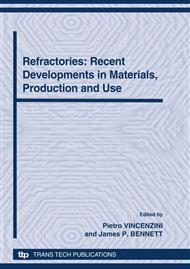[1]
Nippon Steel Guidebook (2009), pp.41-47.
Google Scholar
[2]
Bulletin of the Technical Association of Refractories of Japan, Vol. 709 (5) (2009), P. 6.
Google Scholar
[3]
Seiji Asou et al: Taikabutsu Vol. 48 (6) (1996), p.301.
Google Scholar
[4]
Hiroyuki Ishimatsu et al, Taikabutsu Vol. 61 (2) (2009), p.60.
Google Scholar
[5]
Takashi Miwa: Proceedings of the 5th International Congress on the Science and Technology of Ironmaking, Vol. (2009), p.14.
Google Scholar
[6]
Norio Nitta et al, the Nippon Steel Technical Report , Vol. 388 (2008), p.48.
Google Scholar
[7]
Outcome Report Commemorating 55th Okouchi Commemoration FoundationWinner, (2009), p.98.
Google Scholar
[8]
Kenji Katou, the Bulletin of the Japan Institute of Energy, Vol. 89 (1) (2010), p.9.
Google Scholar
[9]
Kiyokazu Sasaki et al, Tetsu to Hagane , Vol. 69 (15) (1983), p.1818.
Google Scholar
[10]
Naonori Moritama, Taikabutsu , Vol. 37 (9) (1985), p.496.
Google Scholar
[11]
Yasuhira Shimada et al, Taikabutsu , Vol. 40 (9) (1988), p.550.
Google Scholar
[12]
Tsunemi Ochiai et al, the Nippon Steel Technical Report, Vol. 388 (2008), p.18.
Google Scholar
[13]
Hidetoshi Matsuno, Feramu, Vol. 10 (4) (2005), p.32.
Google Scholar
[14]
Hideyuki Ishikawa et al, Taikabutsu , Vol. 48 (8) (1996), p.436.
Google Scholar
[15]
Keisuke Asano et al, Taikabutsu , Vol. 42 (11) (1990), p.705.
Google Scholar
[16]
Nakajima et al, CAMP-ISIJ, Vol. 15 (2002), p.208.
Google Scholar
[17]
Kohei Shimada et al, Seitetsu Kenkyu , Vol. 331 (1988), p.20.
Google Scholar
[18]
Kohei Shimada et al, Tetsu to Hagane , Vol. 71 (4) (1985), p.230.
Google Scholar
[19]
Satoshi Ito et al, the Nippon Steel Technical Report , Vol. 388 (2008), p.62.
Google Scholar
[20]
Kazuo Maeda et al, Taikabutsu , Vol. 46 (11) (1994), p.577.
Google Scholar
[21]
Hatsuo Taira et al, Taikabutsu , Vol. 55 (1) (2003), p.19.
Google Scholar
[22]
Naoki Tsutsui et al, CAMP-ISIJ Vol. 7 (1994), p.238.
Google Scholar
[23]
Tadashi Ikemoto et al, the Nippon Steel Technical Report , Vol. 388 (2008), p.87.
Google Scholar
[24]
Hatsuo Taira et al, the Nippon Steel Technical Report , Vol. 388 (2008), p.69.
Google Scholar
[25]
Takashi Uchida et al, Taikabutsu , Vol. 57 (3) (2005), p.116.
Google Scholar
[26]
Taijiro Matsui et al: Ceramic data book, in Industry and Product Vol. 91 10 (2009), p.145, edited by the Industrial Product Technology Association.
Google Scholar
[27]
Isamu Kifune et al, Seitetsu Kenkyu , Vol. 331 (1988), p.34.
Google Scholar
[28]
Development of ceramic fibers and heat insulation technology, Nippon Steel Technical Report , Vol. 388 (2008), p.110.
Google Scholar
[29]
Yamamura K.et al, Proceedings of the UNITECR Congress (2003), Osaka, Japan,Vol. 10 P. 384.
Google Scholar
[30]
Taijiro Matsui et al, the Nippon Steel Technical Report , Vol. 388 (2008), p.41.
Google Scholar


